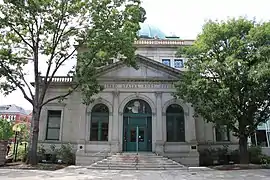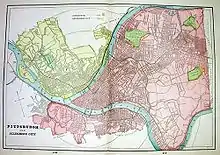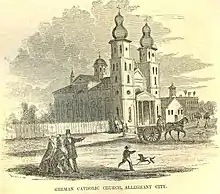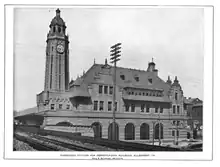Allegheny City | |
|---|---|
 The Allegheny Post Office, one of the remaining structures of Allegheny City's downtown | |
 Allegheny City  Allegheny City | |
| Coordinates: 40°26′30″N 80°00′00″W / 40.44167°N 80.00000°W | |
| Country | United States |
| State | Pennsylvania |
| County | Allegheny |
| Founded | 1788 |
| Incorporated (borough) | 1828 |
| Incorporated (city) | 1840 |
| Annexed (Pittsburgh) | 1907 |
| Elevation | 1,370 ft (420 m) |
| Population (1900) | 129,896 |
| Time zone | UTC-5 (EST) |
| • Summer (DST) | UTC-4 (EDT) |
| ZIP Code | 15212, 15214, 15233 |
| Area code | 412 |
Allegheny City was a municipality that existed in the U.S. state of Pennsylvania from 1788 until it was annexed by Pittsburgh in 1907. It was located north across the Allegheny River from downtown Pittsburgh, with its southwest border formed by the Ohio River, and is known today as the North Side. The city's waterfront district, along the Allegheny and Ohio rivers, became Pittsburgh's North Shore neighborhood.
The area of Allegheny City included the present Pittsburgh neighborhoods of Allegheny Center, Allegheny West, Brighton Heights, California-Kirkbride, Central Northside, Chateau, East Allegheny, Fineview, Manchester, Marshall-Shadeland, North Shore, Northview Heights, Perry North, Perry South, Spring Garden, Spring Hill–City View, Summer Hill, and Troy Hill.
History


| Census | Pop. | Note | %± |
|---|---|---|---|
| 1830 | 2,801 | — | |
| 1840 | 10,089 | 260.2% | |
| 1850 | 21,262 | 110.7% | |
| 1860 | 28,702 | 35.0% | |
| 1870 | 53,180 | 85.3% | |
| 1880 | 78,682 | 48.0% | |
| 1890 | 105,287 | 33.8% | |
| 1900 | 129,896 | 23.4% |
Allegheny was laid out in 1788 according to a plan by John Redick. The lots were sold in Philadelphia by Pennsylvania's state government or given as payment to Revolutionary War veterans. It was incorporated as a borough in 1828 and as a city in 1840. Prior to the 1850s, most of the area was still largely farmland, but was subdivided into residential lots, first for the growing German population and later for Croat immigrants. It was commonly referred to as "Deutschtown," derived from the German word Deutsch, referring to the language and ethnicity.
Allegheny annexed adjoining municipalities such as the boroughs of Manchester, Spring Garden and Duquesne, and the areas that became Brighton Heights, Observatory Hill, Perry Hilltop, Summer Hill, Spring Hill and Troy Hill.[1]
The annexation of Allegheny by Pittsburgh began in 1906 and was effected in 1907, authorized by the U.S. Supreme Court in a landmark decision Hunter v. City of Pittsburgh that year.[2] It was approved by the federal government in 1911. The annexation was controversial at the time, as an overwhelming majority of Allegheny City residents were opposed to the merger. Previous Pennsylvania law had directed that a majority of the voters in each merging municipality had to approve an annexation agreement. In 1906, the State Assembly passed a new law that authorized annexations if a majority of the total voters in both combined municipalities approved the merger. The annexation was rejected by the residents of Allegheny City by a 2:1 margin, but was approved by much more populous Pittsburgh residents, and the annexation bill passed into law. Allegheny City residents tried unsuccessfully for years to have the annexation overturned in court.
The population of Pittsburgh rose from 321,616 in 1900 to 533,905 in 1910, which included the 132,283 who lived in Allegheny in 1910, when the last separate census of Allegheny was taken.
When the two cities were joined, both of the old ward systems were discarded. A new ward system was established made up of 27 wards. In the new ward system, Allegheny was divided into wards 21 to 27. Its past territory is easily seen by viewing a map of the city wards.
In the 1960s, Pittsburgh undertook a massive urban redevelopment project that demolished the historic core of Allegheny City, leaving only the Commons of Allegheny Center and its surrounding neighborhoods. The Carnegie Library, the Old Post Office Building, and the Buhl Planetarium buildings were not demolished. Major portions of the neighborhoods of Allegheny West, Manchester, Central Northside, California-Kirkbride (Old Allegheny Rows), and East Allegheny are listed on the National Register of Historic Places, including the Mexican War Streets in Central Northside.
Industry

Allegheny was an industrial city and had numerous commercial areas, churches, and social organizations, packing houses, tanneries, soap factories and glue factories that provided opportunities for employment to the primarily German immigrants who settled there. The H.J. Heinz Company built its factory in Allegheny City, close to the Chestnut Street bridge (this has been replaced by the 16th Street Bridge). Heyl & Patterson Inc., a manufacturer of railcar dumpers and ship unloaders, also established a factory in Allegheny City. The surviving structures are now occupied by a furniture warehouse and a bus garage.
By the middle of the 19th century, the "Made in Allegheny" label could be found not only on basic iron but on rope, plows, cotton cloth, wool, food, paper, paint, steam engines, wagons and carts, meat, soap, candles, lumber, linseed oil, furniture and a host of other diversified products.[3] Railroad lines were built along the north side of the Allegheny for the Pittsburgh, Fort Wayne and Chicago and the Pittsburgh, Cincinnati, Chicago and St. Louis Railroad railroads in Allegheny. When workers in Pittsburgh struck against the Pennsylvania Railroad after wage cuts in July 1877, railroad workers on these lines also went on strike.[4][5]
Historic places
Teutonia Männerchor
The Teutonia Männerchor Hall in the East Allegheny (Deutschtown) neighborhood of Pittsburgh, Pennsylvania, is a building constructed in 1888. It was listed on the National Register of Historic Places in 2004. The Teutonia Männerchor is a private membership club with the purpose of furthering choral singing, German cultural traditions and good fellowship. The club features a number of heritage activities and celebrations, including choral singing in German and folk dancing.
The Priory
The Priory is the name for two historic landmarks – the 1852 St. Mary's German Catholic Church and the adjacent 1888 home for Bavarian Benedictine priests and brothers. Once a largely German parish, the church later merged with nearby Italian and Polish congregations. The church and rectory have since closed. The buildings are operated as a banquet hall and a bed-and-breakfast.
Penn Brewery
Although Penn Brewery began in 1987, it is housed in the old Eberhardt & Ober Brewery (1882–1906) buildings. Penn Brewery makes the award-winning Penn Pilsner and a number of other specialty beers. The "tied house" (brewery owned restaurant) features a full German menu and live music.
Saint Nicholas Church
Saint Nicholas Croatian Catholic Church, nestled in the hillside above the Allegheny River, was the first Croatian Church built in the United States. The structure was razed in January 2013.
Ridge Avenue Neighborhood
Ridge Avenue, in its heyday between 1890 and 1910, was known as "Millionaires' Row". After 20 years, the area began to decline as some residents moved further out. The entire North Side community began to fray after having been annexed by Pittsburgh in 1907.
Mexican War Streets
In the late 19th century, Allegheny became known for its stately homes, occupied by some of the area's wealthy families. One such area became known as The Mexican War Streets.
The Mexican War Streets were laid out in 1847 by William Robinson Jr., who had earlier been mayor of the city of Allegheny. Robinson, who contrary to some popular tellings did not actually serve in the Mexican War, subdivided his land and named the new streets after the battles and generals (Buena Vista Street, Filson Way, Monterey Street, Palo Alto Street, Resaca Place, Sherman Avenue, Taylor Avenue) of that war.[6]
Carnegie Free Public Libraries
Through his foundation matching fund, Andrew Carnegie contributed to the financing and construction of the Carnegie Free Library of Allegheny in Allegheny City.
St. Anthony Chapel
Built on Troy Hill between 1880 & 1892 by Father Suitbert Mollinger, the chapel houses the largest collection of religious relics outside of the Vatican and features life sized Stations of the Cross statues.
Ball Parks
Allegheny was the location of Exposition Park, the home field of the professional baseball team named the Pittsburgh Pirates (originally called the Pittsburgh Alleghenies and Pittsburgh Innocents). Today, the North Side of Pittsburgh houses PNC Park, home of the Pittsburgh Pirates, and Heinz Field, home of the Pittsburgh Steelers. These facilities replaced Three Rivers Stadium, which was the shared home of both teams.
Felix Brunot Mansion
The Felix Brunot mansion on Stockton Avenue was once used as a station on the Underground Railroad.[7] Fugitive slaves from the South stopped here for food and shelter. While Pennsylvania was a free state, many slaves continued to Canada to gain more distance from slavecatchers.
Allegheny Observatory
The original Allegheny Observatory was built in 1859 near Perrysville Avenue, by prominent Allegheny citizens who formed the Allegheny Telescope Association. The association donated the observatory to the Western University of Pennsylvania (now the University of Pittsburgh) in 1867, after which it was used for astrophysical, solar, and planetary studies. The observatory maintained a successful subscription time service to railroads via telegraph for many years. A new Allegheny Observatory was built between 1900–1912 in today's Riverview Park. It is owned and operated by the University of Pittsburgh for education, astronomical research, and public lectures and tours.
Notable people
- Dwight Edward Aultman (1872-1929), born in Allegheny City. Brigadier General, Veteran of Spanish American War, WW1, Commander of Camp Knox and Fort Sill
- Nellie Bly (1864-1922), American journalist, industrialist, inventor, and charity worker
- John A. Brashear (1840–1920), scientific instrument engineer
- Andrew Carnegie (1835–1919), Scottish native immigrated to Allegheny City at age 13, steel industrialist and philanthropist
- Alexander Cassatt (1839–1906), born in Allegheny City on December 8, 1839, executive of Pennsylvania Railroad and brother of artist Mary Cassatt (next entry)
- Mary Cassatt (1844–1926), born in Allegheny City on May 22, 1844, American impressionist painter and printmaker
- Willa Cather (1873–1947), American novelist, taught English at Allegheny High School from 1903 to 1906
- David L. Clark (1864–1939), founder of Allegheny City candy manufacturer D. L. Clark Company, maker of the Clark Bar
- Alexander Gilmore Cochran (1846–1928), born in Allegheny City, was a Democratic member of the U.S. House of Representatives from Pennsylvania
- William Henry Conley (1840–1897), born in Allegheny City, steel industrialist, first president of the Watch Tower Bible and Tract Society, cofounder of the Jehovah's Witnesses religious group
- Stanley Fields (1883–1941), actor, born in Allegheny City
- Mary Porter Gamewell (1848-1906), American missionary to China
- Lillian Burkhart Goldsmith (1871–1958), Los Angeles real estate developer and lecturer
- Martha Graham (1894–1991), born in Allegheny City on May 11, 1894, modern dancer and choreographer
- Kate Harrington (1831–1917), born in Allegheny City on September 20, 1831, teacher, writer, and poet
- George Washington Harris (1814–1869), born in Allegheny City, steamboat captain and noted humorist, including the "Sut Lovingood" stories[8]
- Frederick Orrin Hartman (1868–1938), was a third baseman in Major League Baseball[9]
- Eleanor Hiestand Moore (1859-1923), suffragist, writer, editor, physician
- Elijah Hise (1802–1867), born in Allegheny City, lawyer, judge, and United States Congressman from Kentucky[8]
- Robinson Jeffers (1887–1963), a poet known for his epic poetry
- Samuel Pierpoint Langley (1834–1906), aviation pioneer, astrophysicist
- Mary A. Miller (18-- – ?), editor and publisher of Methodist Protestant Church missionary periodicals
- Dwight Morrow (1873–1931), moved to Allegheny City at age 2, banker/diplomat
- Henry Phipps, Jr. (1839–1930), moved to Allegheny as a child, financier/philanthropist
- John Pitcairn (1841–1916) Scottish-American industrialist who founded PPG Industries; emigrated to Allegheny City at age 5
- William Plankinton (1843–1905), businessman
- Mary Roberts Rinehart (1876–1958), mystery author, born in Allegheny City
- John Buchanan Robinson (1846–1933), politician, born in Allegheny City
- William Robinson, Jr., (1785–1868), politician, businessman and militia general – first mayor of Allegheny City
- Art Rooney (1901–1988), founding owner of the Pittsburgh Steelers franchise of National Football League
- Charles Taze Russell (1852–1916), born in Allegheny City, first president of the Watch Tower Bible and Tract Society, founder of the Bible Students, one branch of which became the Jehovah's Witnesses after his death.
- George E. Smith or "Pittsburgh Phil" (1862–1905), 1870s resident that became a noted gambler and Thoroughbred owner
- John M. Snowden (1776–1845), served as Mayor of Pittsburgh City from 1825 to 1828.
- Leo Stein (1872–1947), born in Allegheny City on May 11, 1872, art collector and critic
- Gertrude Stein (1874–1946), born in Allegheny City on February 2, 1874, American avant-garde writer
- Harry Todd (1863–1935), actor, born in Allegheny City[10]
- Ellwood J. Turner (1886-1948), Pennsylvania State Representative from Delaware County (1925-1948), Speaker Pennsylvania House of Representatives (1939-1941)
- Lois Weber (1879–1939), born in Allegheny City, pioneer silent film actor, screenwriter, producer, and director
See also
References
- ↑ Allegheny City: A History of Pittsburgh’s North Side, by Dan Rooney and Carol Peterson. University of Pittsburgh Press, 2013. Page 130. Accessed 6 October 2019.
- ↑ "U.S. Supreme Court, HUNTER v. CITY OF PITTSBURGH, 207 U.S. 161 (1907)". Retrieved 2007-12-12.
- ↑ Jack McKee, "The North Side Story", in North Side Directory Chamber of Commerce Members 1960–61
- ↑ Report of the Committee Appointed to Investigate the Railroad Riots in July, 1877, Harrisburg: L.S. Hart, state printer, 1878
- ↑ Lloyd, John P. (2009). "The Strike Wave of 1877". The Encyclopedia of Strikes in American History. Routledge. pp. 182–185.
- ↑ Rooney, Dan; Peterson, Carol (2013). Allegheny City: A History of Pittsburgh's North Side. University of Pittsburgh Press. pp. 32–33. ISBN 978-0-8229-4422-5.
- ↑ William J. Switala, Underground Railroad in Pennsylvania
- 1 2 Who Was Who in America, Historical Volume, 1607–1896. Chicago: Marquis Who's Who. 1963.
- ↑ "Fred Hartman Statistics and History". baseball-reference.com
- ↑ "Death Takes Harry Todd, Veteran Stage-Film Character Actor". Hollywood Citizen-News. February 16, 1935. p. 9. Retrieved January 13, 2024.
External links
- Allegheny City Commercial Districts
- Allegheny City Society
- Allegheny City Historic Gallery
- Frederick P. Mayer, "North Side: A Day in Old Allegheny", Pittsburgh Record, June 1930.
- Across the river Carnegie Library of Pittsburgh historical reprint
- David M. Brown, "A giant forged", Pittsburgh Tribune-Review, 11 June 2006, reprint at Pittsburgh History & Landmarks Foundation
- David M. Brown, "Society marks 1907 annexation of Allegheny City", Pittsburgh Tribune-Review, 28 July 2007
- German Heritage Sites in Pittsburgh and Allegheny City, Washington and Jefferson College
- The Teutonia Männerchor
- Underground Railroad in Pennsylvania